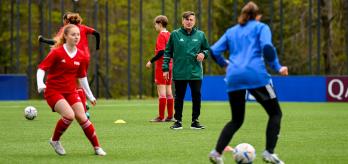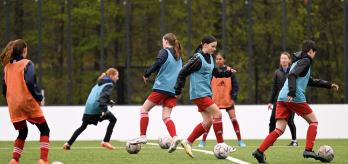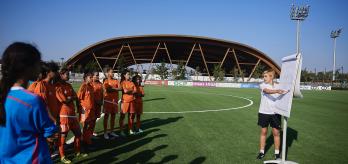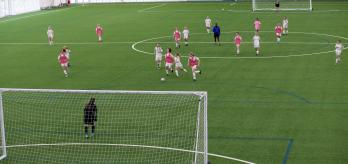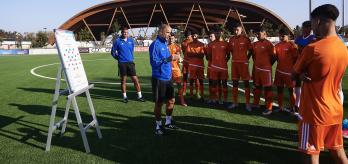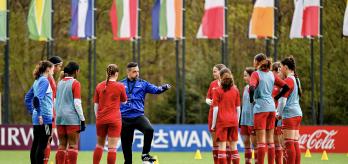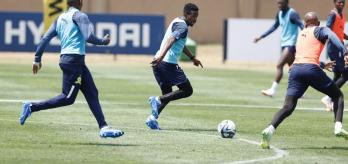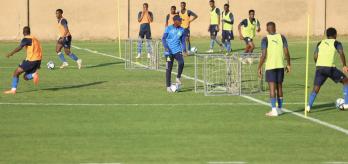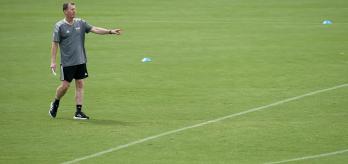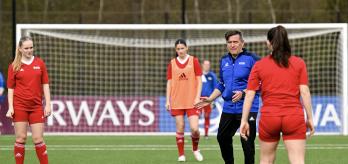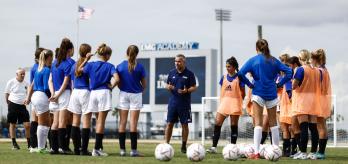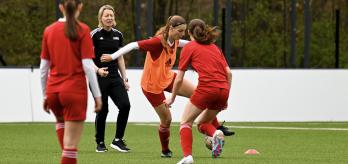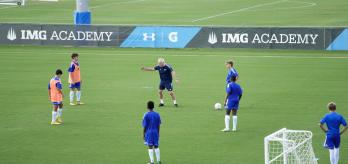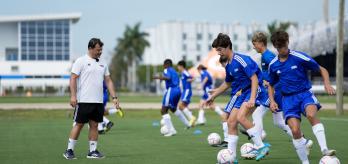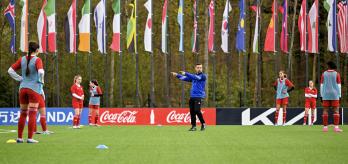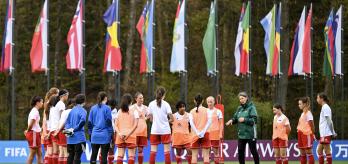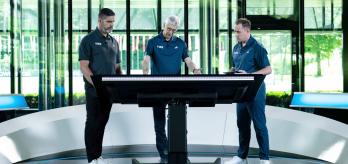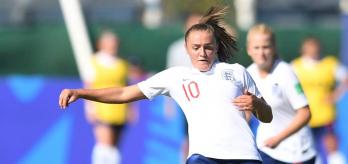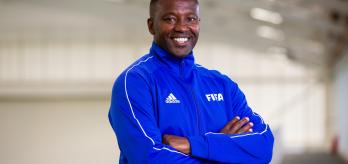When in possession, a player must be able to execute a change of pace and direction, which can help them to evade the attentions of an opponent and progress the ball. Executing a sudden, explosive change of pace can allow players to move the ball into dangerous areas quickly, whilst an abrupt change of direction can enable players to receive the ball in space and with time.
In this session, FIFA Technical Expert Mauricio Marques delivers a series of exercises focusing on ball manipulation and control to a group of boys. The session gets under way with an exercise in which the players are asked to dribble the ball freely in space and perform movements and ball skills on Marques’s command. The next exercise involves players executing quick changes of pace and direction – individually and then in pairs. The final exercise starts with unopposed two- and three-player passing combinations and progresses into 2v1 and 3v2 scenarios, before ending with a 6v4 attack v. defence game.
Session overview
Key coaching points
-
Players should maintain close control of the ball at all times to help them to avoid obstacles, to find space easily and be ready to execute a change of direction.
-
Players should keep an eye on both the ball and their surroundings, as this helps them to adapt to what is going on around them whilst keeping the ball under close control.
-
A quick change of direction should be treated in the same way as a feint that serves to evade the attention of an opponent when under pressure.
-
A burst of acceleration can help players to show the ball carrier the space into which a positive pass can be played.
-
Encourage players to play with their heads up and to be aware of their surroundings at all times.
Part 1: Individual skills and on-the-ball movements
The first exercise focuses on the players’ dribbling skills and on-the-ball movements. The players are asked to perform a series of actions and movements with the ball while keeping it under close control and showing awareness of their surroundings.
-
Use a non-limited exercise area.
-
Give each player a ball.
-
The coach blows their whistle to signal the action that the players must perform with the ball.
The coach instructs the players to perform the following dribbling actions, skills and movements:
-
Dribble to the left
-
Dribble to the right
-
Dribble forwards
-
Dribble backwards whilst facing forwards
-
Juggle the ball
-
Perform a 360° spin on the ball
-
Instead of using the whistle to attract the players’ attention before giving a new command, the coach uses hand gestures.
-
Players must pay attention to other players’ movement to avoid colliding with them.
-
Players must maintain close ball control and adopt a flexible body shape in readiness to change direction or skill at any time.
-
Players must keep an eye on both the coach and the ball to be able to respond quickly to the coach’s commands. Encourage players to play with their heads up.
Part 2: Change of pace and direction
This exercise develops the players’ ability to execute a change of pace and direction when dribbling with the ball and immediately before receiving a pass. The players are asked to make short, quick bursts in an attempt to deceive and evade the attentions of an imaginary opponent.
-
Use a non-limited exercise area.
-
Give each player a ball.
-
When the coach call outs “Pace”, the players dribble freely at a moderate tempo in the open exercise area while avoiding colliding with one other.
-
When the coach calls out “Change”, the players must significantly increase the tempo, dribbling at high speed whilst maintaining control of the ball.
-
The players must execute quick changes of direction to avoid colliding with each other.
-
When the coach calls out “Pace” again, the players revert to dribbling at a moderate tempo.
-
The players form pairs and pass the ball back and forth between themselves using one ball.
-
When the coach calls out “Change”, the players raise their intensity levels, with the receiver executing a quick change of direction immediately before receiving their partner’s pass.
-
The receiving player then becomes the passer, and their partner must execute a directional change before receiving the pass.
-
Playing with their heads up enables players to identify oncoming obstacles and to change direction quickly and smoothly.
-
Accelerating with the ball when executing a change of direction and pace allows players to overcome opponents.
-
When executing a change of direction to receive the ball, the receiving player must imagine that they are trying to lose or deceive an opponent.
-
Players should maintain close control of the ball when dribbling at moderate pace and changing direction to avoid making mistakes or running into traffic.
Part 3: Attack v. defence – 2v1, 3v2 and 6v4
The passing sequences involved in this final exercise progressively build on the players’ ability to execute a change of direction and pace when combing in small numbers to overcome an opposition defence. The exercise initially involves unopposed passing sequences, before defenders are introduced to increase the level of difficulty.
-
Use half of a full-size pitch.
-
Mark out a 15-metre-wide corridor in each wide area and a wider central corridor. All three corridors begin 10m from the halfway line and run up to the edge of the penalty area.
-
Split the group into 3 teams, assigning each team to a corridor.
-
In each wide corridor, position 2 players alongside each other at the starting point (10m from the halfway line) and give them a ball.
-
In the central corridor, position 3 players alongside each other and give them a ball.
-
In each of the 2 wide corridors, the sequence starts with one of the pair sprinting into space.
-
As the player arrives in the space, they must change direction and open their body to face their partner and receive a pass.
-
The passing player then sprints ahead of their partner and performs the same action to receive the ball in space.
-
Once the passing sequence reaches the penalty area, one of the pair dribbles the ball back to the starting point around the outside of their wide corridor.
-
In the central corridor, a 3-player figure-of-eight passing sequence is performed.
-
Players must pass the ball to the opposite side of the corridor and follow their pass at all times.
-
Once the passing sequence reaches the penalty area, one of the three players dribbles the ball back to the starting point around the outside of the central corridor.
-
Once they have finished a passing sequence and return to the starting point, players move to the sequence to their right.
Variation 1
-
Create match-realistic attack v. defence scenarios by introducing defenders in each of the three corridors and placing a goalkeeper in the full-size goal (with another goalkeeper waiting beside the goal).
-
In the 2 wide corridors, add 1 defender to create a 2v1 scenario; in the central corridor, add 2 defenders to set up a 3v2 scenario.
-
The exercise begins with the goalkeeper playing the ball to the attackers, who are tasked with combining to progress up the pitch and finish on goal.
-
If the defending team win the ball, they can attack the mini goal positioned on the halfway line.
-
The offside rule applies, and the goalkeepers should swap roles after every few attacks.
Variation 2
-
The attackers have 12 seconds in which to finish on goal.
Variation 3
-
Remove the 3 corridors and set up a 6v4 attack v. defence scenario. Five attackers begin the exercise at the starting point, whilst 1 attacker takes up a position in the defensive line.
-
If the defending team win the ball, they can try to score in any of the 3 mini goals positioned on the halfway line.
-
After an attempt on goal at either end of the exercise area, the second goalkeeper enters the exercise area and engages the first goalkeeper in a 1v1 scenario.
-
If the attackers lose the ball, they have 6 seconds in which to regain possession. If they fail to win the ball back within 6 seconds, the defending team are awarded a point.
-
After each attack, the goalkeepers restart play by passing the ball towards an attacker positioned on the halfway line, taking it in turns to pass to the left, centre and right.
-
Executing a quick change of direction with an open body shape allows players to receive the ball smoothly.
-
Playing firm passes into the space a player will occupy helps to improve the fluency of passing sequences.
-
Off-ball movement, such as executing a change of pace and direction, can deceive defenders and create space for team-mates in other areas of the pitch.
-
Following their passes allows players to make off-the-ball runs that go unnoticed by the opposition.
















